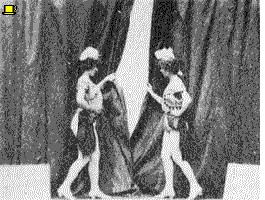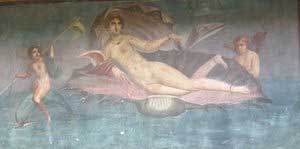.

Venus Anadyomene
Venus Anadyomene[1] ("Venus Rising From the Sea") was one of the iconic representations of Aphrodite, made famous in a much-admired painting by Apelles, now lost, but described in Pliny's Natural History with the anecdote that the great Apelles employed Campaspe, a mistress of Alexander the Great, for his model. The image represents the Goddess of Love emerging from the waters, as she was first born of the sea or from those that perpetually renewed her virginity, and wringing out her hair. The subject was often repeated in Antiquity, a fourth-century sculptural representation from a Gallo-Roman villa in Aquitania testifying to the motif's continued viability in Late Antiquity.


(Image: freedigitalphotos.net )
This mural from Pompeii is believed to be based on Anadyomene Venus, a lost painting by Apelles
Through the desire of Renaissance artists reading Pliny to emulate Apelles, and if possible to outdo him, Venus Anadyomene was taken up again in the fifteenth century: beside Botticelli's famous Birth of Venus (Uffizi Gallery, Florence), another early Venus Anadyomene is the bas-relief by Antonio Lombardo from Wilton House (Victoria and Albert Museum, London). Titian's Venus Anadyomene, c. 1525, formerly a long-term loan by the Duke of Sutherland, was 2003's acquisition of the year at the National Gallery of Scotland, Edinburgh (illustration, right).
Venus Anadyomene offered a natural subject for a fountain: the National Gallery of Art, Washington DC has a lifesize bronze plumbed so that water drips from Venus' hair, modelled by a close follower of Giambologna, late sixteenth century. Rococo sculptures of the subject were modestly draped across the hips, but bolder nudes appealed to male nineteenth-century patrons: Théodore Chassériau executed the subject in 1835 and Jean-Auguste-Dominique Ingres' Venus Anadyomene, completed after many years in 1848, is one of the painter's most celebrated works (Musée Condé, Chantilly, France).
In 1870 Arthur Rimbaud evoked the image of a portly Clara Venus ("famous Venus") with all-too-human blemishes (déficits) in a sardonic poem that introduced cellulite to high literature: La graisse sous la peau paraît en feuilles plates (the fat under the skin appears in slabs).
Pablo Picasso recast the image of Venus Anadyomene in the central figure of his seminal painting Les Demoiselles d'Avignon (1907), a modernist deconstruction of the icon, and one of the incunabula of Cubism.
Venus Rising from the Sea, Titian
Venus Anadyomene, Antonio Maria Esquivel

Birth of Venus , Arnold Böcklin

- ^ Anadyomene, "rising up".
References
- Venus Anadyomene, Roman villa of Petit-Corbin, Gironde (Musée du Louvre)
- Antonio Lombardo, Venus Anadyomene
- Venus Anadyomene, National Gallery of Art
- Arthur Rimbaud, "Vénus Anadyomène"
- T.R. Quigley, "Semiotics and Western Painting", 1994 Picasso's Demoiselles d'Avignon.
See also : Greek Mythology. Paintings, Drawings
| Ancient Greece
Science, Technology , Medicine , Warfare, , Biographies , Life , Cities/Places/Maps , Arts , Literature , Philosophy ,Olympics, Mythology , History , Images Medieval Greece / Byzantine Empire Science, Technology, Arts, , Warfare , Literature, Biographies, Icons, History Modern Greece Cities, Islands, Regions, Fauna/Flora ,Biographies , History , Warfare, Science/Technology, Literature, Music , Arts , Film/Actors , Sport , Fashion --- |
Retrieved from "http://en.wikipedia.org"
All text is available under the terms of the GNU Free Documentation License



